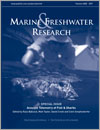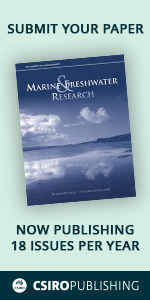Marine and Freshwater Research
Volume 68
Number 8 2017
Acoustic Telemetry of Fish & Sharks
This review provides insight into the important role that acoustic telemetry plays in the research and management of Australian aquatic ecosystems. Application of the technology transcends aquatic environments and bureaucracies, and the patterns revealed are relevant to many of the contemporary challenges facing decision makers with oversight of aquatic populations or ecosystems. Improved knowledge of aquatic movement ecology ultimately supports informed and adaptive management approaches.
This study assessed the efficiency of a national acoustic telemetry network to detect passing animals. The aim was to determine how many receivers could be decommissioned from each of the eight curtains while maintaining its integrity. Applying predefined criteria, we were able to improve the network significantly, reducing the number of stations by 36%, yet still retaining 84% of total detections, 86% of transmitters and 100% of detected species. This study provides a useful framework for refining acoustic telemetry networks.
The movements of Port Jackson sharks captured in Jervis Bay on the NSW south coast were tracked, finding that sharks migrate thousands of kilometres each year to their feeding sites in Bass Strait. Males and females return to the same breeding reef each year. Males migrate more quickly than females and the trip south is faster than the trip north.
Acoustic tagging and tracking of spangled emperor (Lethrinus nebulosus) indicated that although home range locations of some individuals varied according diel and tidal signals, variation among individuals was generally greater than that related to environmental signals. Individual home range sizes were similar across diel and tidal cycles. Seasonal variation in habitat use included annual migrations, sometimes over 100 km, to potential spawning locations that coincided with particular lunar phases.
The patterns of distribution and abundance of snapper in South Australia changed throughout the 2000s, subsequently affecting the best approach for managing snapper fisheries. The aim of the present study was to investigate snapper movement behaviour, revealing aspects of its spatial scope, seasonal variation and systematic nature. The findings revealed the complexity of snapper movement, which is beneficial for developing appropriate fishery and spatial ecosystem management approaches.
The herbivorous coral reef fish Kyphosus bigibbus was tagged with acoustic transmitters revealing that this species has a larger home range area than documented previously for any other coral reef herbivorous fish. The fish showed long-term fidelity (up to 20 months) to particular home reefs and within the school with which they were tagged. Patterns of habitat use varied substantially, despite the close proximity of these home reefs.
Movement and dietary patterns of two co-occurring predatory reef fish were examined at Orpheus Island, Australia, respectively using acoustic telemetry and stable isotopes. The findings show low spatial overlap, but high dietary overlap between Plectropomus leopardus and P. maculatus, which may be a product of competition for resources. This research provides new species-specific information about resource use within a genus commonly reported as a single entity.
Movement patterns of yellowfin bream (Acanthopagrus australis) released at artificial and natural reef sites within a coastal lake indicate that fish associated with the artificial reef system were detected for considerably longer periods, with greater numbers of fish identified as resident within the artificial reef system. A longer range movements >200 km was also detected.
The presence and movement patterns of eastern fiddler rays (Trygonorrhina fasciata), Port Jackson sharks (Heterodontus portusjacksoni) and bluespotted flathead (Platycephalus caeruleopunctatus) were monitored using acoustic telemetry around an artificial reef (AR) to examine the degree of site attachment and the potential for fish production at this reef. All three species moved frequently between the AR and nearby natural reefs, and their moderate presence at the AR indicates that this reef has been incorporated by these species into their natural range.
Marine protected areas (MPAs) can benefit mobile sharks when essential nursery habitats are characterised and protected. In this study, the movement patterns of two reef shark species were investigated relative to a MPA in northern Australia. No-take MPAs encompassing sandflat and vegetated habitats can benefit juvenile sicklefin lemon sharks that exhibit residency and affinity to these features, but will have limited benefit for juvenile blacktip reef sharks that have broader movements.
This study monitored the movements of 89 acoustically tagged white sharks (Carcharodon carcharias) around southern and western Australia, using an extensive network of passive acoustic receivers. Results indicate little evidence of predictable or coordinated movements among individual sharks. Nevertheless, these data can inform initiatives to mitigate the risks associated with human encounters with white sharks.
The behaviour of the air breathing Australian Lungfish was assessed in three dimensions within a large riverine impoundment using an acoustic array and depth sensors. We found that lake stratification constrained fish depth use, however the total volumetric activity space used remained similar between stratified and un-stratified periods. The use of a 3-D modelling approach to describe fish activity space use, revealed information that traditional 2-D fish tracking approaches would not have identified.
We investigated the effects of oocyte development, flow magnitude and artificial barriers on migration behaviour in Australian bass (Percalates novemaculeata). Bass spawning migrations occurred only when gonads were mature and on large flows. Connectivity to estuarine spawning habitats was reduced by instream weirs. Our findings are relevant to water resource managers formulating environmental flow rules for regulated river systems.
Migration is a fundamental aspect of the life history of many fish. This study used acoustic telemetry and analysis of strontium isotopes in otoliths (fish ear stones) to study intraspecific variation in the migrations of barramundi in the Northern Territory, Australia. A revised life history model identifying three migratory contingents is presented to support future management of the species.
Telemetry studies can provide valuable data to fill crucial gaps in our knowledge of the movement behaviours of fish. Herein we use four native Australian fish species as case studies to demonstrate how data derived from telemetry studies can be synthesised into conceptual diagrams to help scientists and managers develop targeted and effective conservation management strategies.




